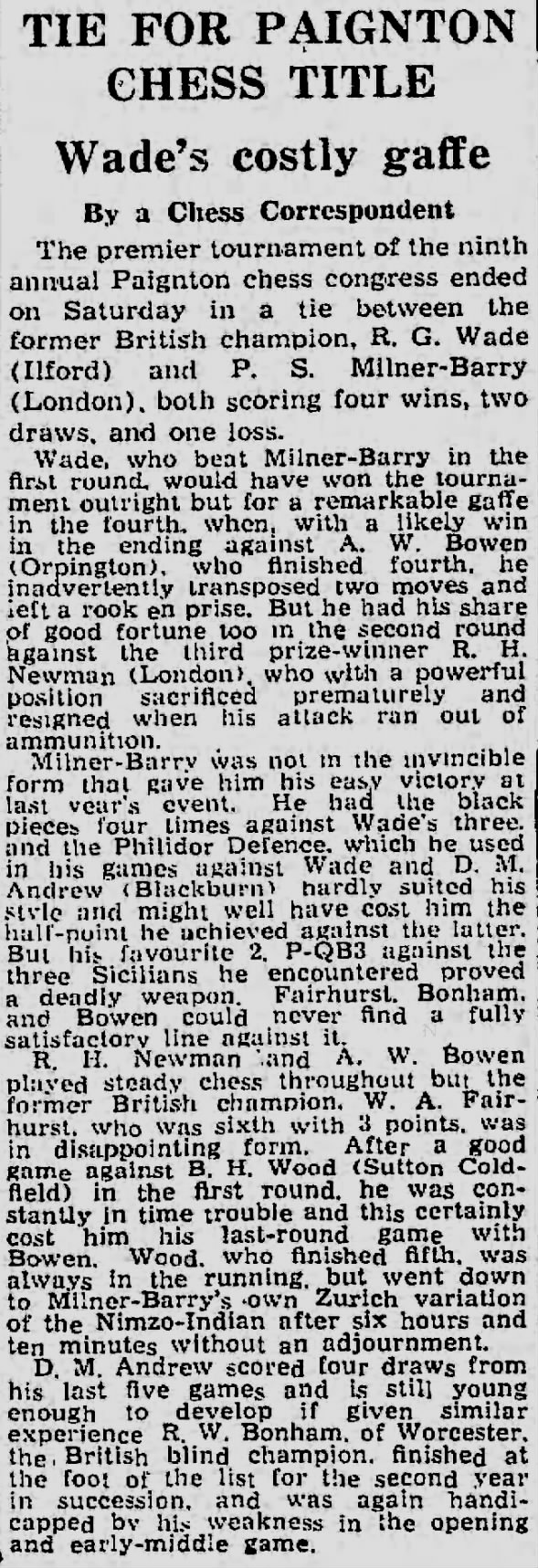 Chess 10 Sep 1959, Thu The Guardian (London, Greater London, England) Newspapers.com
Chess 10 Sep 1959, Thu The Guardian (London, Greater London, England) Newspapers.com
Chess
The Guardian, Chess, Thursday, September 10, 1959, Greater London, England Problem No. 541 bv J. M. Rice...
Posted by Bobby Fischer's True History on Tuesday, May 17, 2022
Problem No. 541 bv J. M. Rice (Cambridge)
Black (10)
White (8)
White mates in two moves.
FEN 4N3/b1r2r2/n3p3/NR1pk3/R1Qp1p2/5P1B/8/2K4n w - - 0 1
Solution: 1. Qc6 Rxc6+ 2. Nxc6#
A 1959 Gambit
Golombek probably knows as much about the English Opening as anyone in the world, and during the recent British championship he won several excellent games with its typical strategy of queens side attack. However, even an ultra-positional variation can produce sparkling tactics if one player neglects development, and in this week's game we have the unusual spectacle of the English being treated like an Evans Gambit.
Harry Golombek vs Alfred Maurice Hallmark
British Championship (1959), York ENG, rd 5, Aug-14
English Opening: Golombek Defense (A16) 1-0
- Weak; Black should transpose into the Queen's Gambit Declined by 3. … P-K3; 4. P-Q4 P-B4.
- Black already has difficulties in protecting his king's pawn. 5. … P-KB3 would badly weaken the diagonal KN-QR7, while 5. … N-QB3; 6. B-N5 Q-Q3; 7. P-Q4 also places his centre under heavy attack.
- Not 6. … P-K5 because of 7. Q-R4ch.
- White now takes instructive advantage of his majority of pawns in the centre. If 7. … P-K5; 8. N-Q2 P-KB4; 9. B-B4, and Black's prospects of castling are remote.
- Here and in the next two moves Black comprises his game by attempting to break up the white centre before completing his development. He should castle, with a cramped game but not yet a lost one.
- Retribution begins; henceforth the black king and queen are unmercifully harried round the board.
- Now the position is remarkably similar to the compromised variation of the Evans Gambit. If 12. … NxP; 13. Q-K3; 14. NxP QxKP; 15. N-B3 Q-R4; 16. Q-K2ch K-B1; 17. QR-Q1 N-B3; when, although Black's king is trapped in the centre, White has no clear winning line.
- Rather better is 13. … Q-K3; 14. NxP QxKP; 15. N-B3 Q-R4; 16. Q-K2ch K-B1; 17. QR-Q1 N-B3; when, although Black's king is trapped in the centre, White has no clear winning line.
- Another weakness, which White is quick to exploit. However, if 15. … Castles; White has the pleasant choice between the simple 16. NxP and the sacrificial 16. BxPch KxB; 17. N-N5ch K-N3 (17. … K-N1; 18. Q-R5 R-Q1; 19. QxPch K-R1; 20. Q-R5ch K-N1; 21. Q-R7ch K-B1; 22. Q-RPch K-K2; 23. QxPch K-K1; 24. Q-B7 mate); 18. Q-B2ch P-B4; 19. PxPe.p.ch KxP; 20. N-K4ch.
- A decisive thrust, for if 18. … PxP; 19. BxP R-KN1; 20. Q-R5ch and Black's game collapses.
- For if 21. … QxP; 22. B-N4, while if 21. … KxP; there is an entertaining finish by 22. B-N4ch K-K3; 23. R-K1ch K-B4; 24. B-Q3ch K-N4; 25. B-Q2ch K-R5; 26. P-N3ch K-R6; 27. B-B1 mate.
 Tie For Paignton Chess Title 14 Sep 1959, Mon The Guardian (London, Greater London, England) Newspapers.com
Tie For Paignton Chess Title 14 Sep 1959, Mon The Guardian (London, Greater London, England) Newspapers.com
TIE FOR PAIGNTON CHESS TITLE
Wade's costly gaffe
By a Chess Correspondent
The premier tournament of the ninth annual Paignton chess congress ended on Saturday in a tie between the former British champion, R. G. Wade (Ilford) and P. S. Milner-Barry (London), both scoring four wins, two draws, and one loss.
Wade, who beat Milner-Barry in the first round, would have won the tournament outright but for a remarkable gaffe in the fourth, when, with a likely win in the ending against A. W. Bowen (Orpington), who finished fourth, he inadvertently transposed two moves and left a rook en prise. But he had his share of good fortune too in the second round against the third prize-winner R. H. Newman (London), who with a powerful position sacrificed prematurely and resigned when his attack ran out of ammunition.
Milner-Barry was not in the invincible form that gave him his easy victory at last year's event. He had the black pieces four times against Wade's three, and the Philidor Defence, which he used in his games against Wade and D. M. Andrew (Blackburn) hardly suited his style and might well have cost him the half-point he achieved against the latter. But his favourite 2. P-QB3 against the three Sicilians he encountered proved a deadly weapon. Fairhurst, Bonham, and Bowen could never find a fully satisfactory line against it.
R. H. Newman and A. W. Bowen played steady chess throughout but the former British champion. W. A. Fairhurst, who was sixth with 3 points, was in disappointing form. After a good game against B. H. Wood (Sutton Coldfield) in the first round, he was constantly in time trouble and this certainly cost him his last-round game with Bowen. Wood, who finished fifth, was always in the running, but went down to Milner-Barry's own Zurich variation of the Nimzo-Indian after six hours and ten minutes without an adjournment.
D. M. Andrew scored four draws from his last five games and is still young enough to develop if given similar experience R. W. Bonham, of Worcester, the British blind champion, finished at the foot of the list for the second year in succession, and was again handicapped by his weakness in the opening and early-middle game.






















